Big Dead Fish, or just Big Dead-in-the-Water Ideas?
Well, after the dust has settled from the crew bus, and the
cameramen have finished trampling on the bones, and the television
interest in Leedsichthys has once again waned after its peak
in September-November 2003 (8/9/2003 The Big Monster Dig on C4, and
23/11/2003 Sea Monsters:A Walking With Dinosaurs Trilogy), what have
we learned? And, perhaps more importantly, what do we have to unlearn?
Perhaps one important thing is the vagaries of model design for
computer-generated animation - RDF and the BBC both had models of Leedsichthys
made for their respective series, and asked the opinions of
myself and Dave Martill over a very short deadline timeframe. RDF's
team (Rhys Griffin of Clockwork Digital being the man on the ground)
was outstanding, and struggled hard to incorporate all the
modifications that we suggested. In comparison, the BBC's team
(Impossible Pictures, seasoned from work on all the 'Walking With…'
franchise products) ignored almost all of the suggestions made by Dave
and myself, and kept pretty much to their original model (dubbed the
'Budweiser lizard fish' for obvious reasons) - which apparently was
nearly completed before Dave and myself were involved. Sometimes,
'involving an expert' is merely an example of gesture politics - the
aim is not necessarily to strive for accuracy, but merely to go
through the motions, and be able to tick the relevant box afterwards.
But one thing that the Impossible Pictures team is most definitely to
be commended for, is not going over the top in the size of the fish.
At 22 metres, their Leedsichthys may be large, but it is not
excessive.
Size isn't everything - or is it? Leedsichthys was a
remarkably large animal. Despite the paucity of its remains, it seems
to be the largest bony fish ever - although it only needs to be over
11 metres in length (the size of the King of Herrings, the living
contender) to claim that title.
This is different from the largest fish of ANY kind ever, as there
are a few living cartilaginous fishes (eg whale shark, basking shark)
and extinct (Megalodon) that are significantly larger than
that figure. Estimates for extinct cartilaginous fishes Edestus
and Helicoprion have occasionally gone over the 15 metre
mark, but these seem to be utterly unsupportable figures.
Similarly, Leedsichthys was well short of the length of the
largest aquatic vertebrate known - the blue whale, which is a mammal
that can grow up to 25 metres in size.
The first published estimated size of Leedsichthys appears
to have been one of 30 feet [=9 metres], by Arthur Smith Woodward in
1905. This was through comparison with the related Pachycormid fish
Hypsocormus. But since the mid eighties, Leedsichthys
has been estimated to be larger and larger - with the supporting
evidence becoming smaller and smaller for each subsequent increase in
size.
The first estimates that exceeded 20 metres appeared in 1986of the
remains of Leedsichthys that were known, he determined to
estimate the full length of the animal, by comparing it to a specimen
of a Pachycormid fish that he had recently discovered in the Oxford
Clay near Peterborough. He looked at a variety of skeletal components
- including the hyomandibulae, the tail, the pectoral fin -from
different specimens of Leedsichthys . Scaling between these
components and the new Pachycormid fish, he came up with the following
sizes:
| Length of individual lobes of caudal
fin |
NHM P10000 |
2.00 metres |
1/7 of total body length |
25cm |
14 metres |
| Length along anterior margin of
pectoral fin |
Uncollected/Anecdotal |
3.00 metres |
1/7 of total body length |
25cm |
21 metres |
| Length of hyomandibula |
NHM P10156 |
70 centimetres |
1/19.4 of total body length |
9cm |
13.5 metres |
| Width of gill basket/skull |
NHM P10156 |
1.2 metres |
1/23 of total body length |
8cm |
27.6 metres |
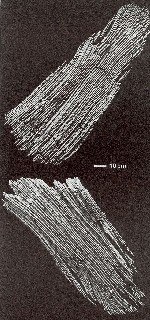 |
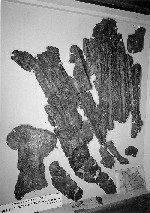 |
| Tail |
Hyomandibula and Gill Basket |
As you can see, the really surprising estimate came from the gill
basket, which produced an estimated length of some 27.6 metres for the
animal - and this is using a conservative approximation of a gill
basket width to substitute for the width of the whole skull.
Linear scaling is fine in principle, but it does not take into
account that non-linear growth tends to occur in animal, with some
components of an animal's body growing faster than others. A case in
point is that the gill basket referred to above (NHM P10156) produced
an estimated length of 27.6 metres, but the hyomandibula of the SAME
individual gave a total length of 13.5 metres. This does call the
methodology sharply into question, and perhaps this technique tells us
less about the full length of this animal, than about the different
rates of growth within the same animal.
Some 15 years on from that work, an estimate of 30 metres has
entered the popular psyche, as part of the script for a popular
palaeontology programme on television. Once again, Martill returned to
that same Pachycormid specimen, and the remarkably complete gill
basket of Leedsichthys . This time, he reasoned that, as this
particular Pachycormid appeared to have a gill basket that was one
third of the length of its head, and this head was in turn about one
fifth of the length of the animal's body, so one could take the
measurement of the gill basket for Leedsichthys , multiply it
by three to produce a head length of 6 metres, then multiply this
figure by five to produce a full length of 30 metres.
There are problems with this. Firstly, this undescribed Peterborough
Pachycormid has an undetermined relationship within the Pachycormids -
although it has been referred to as a species of Asthenocormus
in the past, it bears very little resemblance to this Tithonian
taxon, or Leedsichthys , with which it is being used as a
comparator. Although it appears to have edentulous jaws like Leedsichthys
, there are surprisingly few bones in the Peterborough Pachycormid
that closely resemble the morphologies occurring in Leedsichthys
(the symplectic bone is a notable exception in this regard).
Within Pachycormids as a group, the arrangement of the gill basket
sitting so far back within the head appears to be unique for the
Peterborough Pachycormid. Indeed there are other Pachycormid taxa that
have more comparable bones to Leedsichthys - the Toarcian
Saurostomus
 being
a good example.Secondly, a gill basket is perhaps the worst single
structure in the body of a fish to use for linear scaling: it is the
structure that bears the gill filaments (the virtually 2D soft tissue
respiratory surfaces of the fish). A 2D respiratory surface will
increase out of proportion to the increasing quantity of body tissue
that it is supplying - if you double the length of the body, the area
of gill filaments required will increase by 2 to the power of 3 - in
other words, it will multiply by a factor of eight. Thus you will end
up with a fish with disproportionately large gill basket for the
length of its body and the quantity of tissue that it will be
supplying. Physiologically, this structure might well be the least
suitable to use as a means of estimating body length of an animal, for
this very reason.
being
a good example.Secondly, a gill basket is perhaps the worst single
structure in the body of a fish to use for linear scaling: it is the
structure that bears the gill filaments (the virtually 2D soft tissue
respiratory surfaces of the fish). A 2D respiratory surface will
increase out of proportion to the increasing quantity of body tissue
that it is supplying - if you double the length of the body, the area
of gill filaments required will increase by 2 to the power of 3 - in
other words, it will multiply by a factor of eight. Thus you will end
up with a fish with disproportionately large gill basket for the
length of its body and the quantity of tissue that it will be
supplying. Physiologically, this structure might well be the least
suitable to use as a means of estimating body length of an animal, for
this very reason.
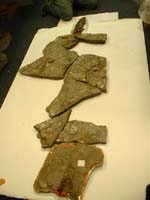 Martill's 1986 work was revisited, in the light of more bones of Leedsichthys
being identified and available for study, and some archival
research by Dr Leslie Noé of the Sedgwick Museum. This work
uncovered a letter from Alfred Leeds recording the actual length of
the caudal lobes used by Martill in his 1986 study, before they were
removed from the clay, and notes that "a good foot" of them
simply could not be picked up because they were too small. The actual
length of the lobes is 1.8 metres prior to excavation - not the 2.0
metres recorded by Martill. Similarly, the size of the Peterborough
Pachycormid is different - noted as 1.75 metres by Martill in 1986, it
actually lays out to be 2.20 metres long.
Martill's 1986 work was revisited, in the light of more bones of Leedsichthys
being identified and available for study, and some archival
research by Dr Leslie Noé of the Sedgwick Museum. This work
uncovered a letter from Alfred Leeds recording the actual length of
the caudal lobes used by Martill in his 1986 study, before they were
removed from the clay, and notes that "a good foot" of them
simply could not be picked up because they were too small. The actual
length of the lobes is 1.8 metres prior to excavation - not the 2.0
metres recorded by Martill. Similarly, the size of the Peterborough
Pachycormid is different - noted as 1.75 metres by Martill in 1986, it
actually lays out to be 2.20 metres long.
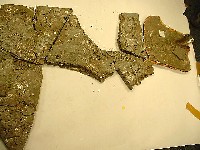 With
these points in mind, the table has been redone refining Martill's
original methodology and selection of elements, excluding the gill
basket measurement (for the physiological reasons outlined above), the
hyomandibula (because it could not be reidentified in the Peterborough
Pachycormid), and the pectoral fin (because as an uncollected specimen
it was unverifiable without photographs or other similar documentation
- although a similar pectoral fin margin at the Ariston locality in
September 2002 measured around 2.3 metres in length).
With
these points in mind, the table has been redone refining Martill's
original methodology and selection of elements, excluding the gill
basket measurement (for the physiological reasons outlined above), the
hyomandibula (because it could not be reidentified in the Peterborough
Pachycormid), and the pectoral fin (because as an uncollected specimen
it was unverifiable without photographs or other similar documentation
- although a similar pectoral fin margin at the Ariston locality in
September 2002 measured around 2.3 metres in length).
| Length of symplectic |
LCM G128.1900 |
39 centimetres |
1/36.67 of total body length |
6cm |
14.3 metres |
| Length of hyomandibula |
NHM P10156 |
70 centimetres |
1/19.4 of total body length |
9cm |
13.5 metres |
| Length along anterior margin of
pectoral fin |
Uncollected/Anecdotal |
unverifiable |
1/7 of total body length |
25.4cm |
|
| Length of individual lobes of caudal
fin |
NHM P10000 |
1.80 metres |
1/7 of total body length |
21.5cm |
12.6 metres |
Repeating the measurements for the specimens originally utilised by
Martill, the resulting figures for estimated body length cluster into
quite a narrow band - from 12.6 to 14.3 metres, for 3 different
individuals of Leedsichthys .
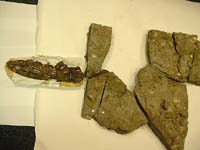 These estimates are, of course, only broad indicators, based on the
specimens that Dave Martill utilised in 1986, and they do not
necessarily have any bearing on the upper (or lower) size that the
fish may have grown to. The new specimen currently under excavation -
Ariston - has (at 87cm in length) the largest hyomandibulae recorded
of any specimen, and if we apply this to Martill's proportions, an
animal of just under 16.9 metres in length results. As another point
in passing, an individual identified as a juvenile specimen of Leedsichthys
(NHM P11823) because of the small size of its hyomandibulae (a
mere 52cm in length), produces an estimated length of just under 10.5
metres.
These estimates are, of course, only broad indicators, based on the
specimens that Dave Martill utilised in 1986, and they do not
necessarily have any bearing on the upper (or lower) size that the
fish may have grown to. The new specimen currently under excavation -
Ariston - has (at 87cm in length) the largest hyomandibulae recorded
of any specimen, and if we apply this to Martill's proportions, an
animal of just under 16.9 metres in length results. As another point
in passing, an individual identified as a juvenile specimen of Leedsichthys
(NHM P11823) because of the small size of its hyomandibulae (a
mere 52cm in length), produces an estimated length of just under 10.5
metres.
Leedsichthys was a remarkable animal. The fact that it grew
to around 15 metres rather than "35 metres…the length of 3
London Buses" (The Sun, 18/9/2003) does not diminish that truth.
No bony fish appears to ever have come even remotely close to its
success (if large size is any measure of success) - the closest
example today - the King of Herrings - only grows to a length of 11
metres through eschewing classical fish body forms (e.g. tuna-shaped),
instead approximating the form of a pencil with fins.
Leedsichthys IS the biggest bony fish ever. It might even
be the biggest fish of all time. But we don't need to increase it to
the size of a whale to make it special - it already is. Furthermore,
Ariston is unquestionably the biggest individual of Leedsichthys
that we have evidence for, as entering its pectoral fin margin
length (approx. 2.3 metres) and hyomandibulae sizes (87cm in length)
into the Martill methodology demonstrates - figures of 16.1 and 16.9
metres respectively result.
Jeff Liston





